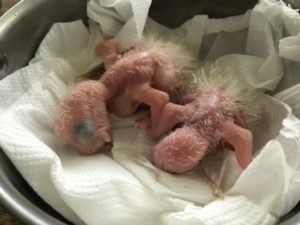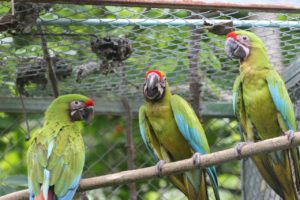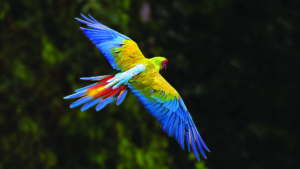It’s a good time to revisit the Macaw Recovery Network (MRN) because it’s spring, and the great green macaw chicks are hatching in the MRN breeding facility as well as their native nests, which are largely found in the endangered Mountain Almond tree. Creating successful offspring is a slow, challenging process for wild macaws. They usually lay three to five eggs, with the expectation that only one to three will be fertile and actually fledge successfully. For a critically endangered species like the great greens, every egg matters!

The Macaw Recovery Network monitors eggs for viability, standing ready to assist those parents who need help. They first candle the eggs to determine fertility, and, if a breeding pair lays more than three fertile eggs or needs help, the eggs are moved to foster parents just prior to hatching. This helps maximize the total number of chicks that may succeed to fledging during the breeding season.
From “Foster Care” to Family Reunion
This year, two couples in the breeding facility laid more than three eggs (Harry/Cooper and Paul/Rio). Both couples needed help so some of the eggs were moved to experienced foster parents. However, the pair named Chicken/Duck were able to raise all three chicks on their own. When foster parents are able to feed the chick successfully, they will grow and start exploring outside the nest at about three months. Once they are weaned by their foster parents at about 6 to 8 months of age, the chicks are reunited with their siblings. How great is that!?

There are only an estimated 1,000 critically endangered great green macaws currently left in the wild, 300 of which are in Costa Rica, so the species needs extra help to rebound and build their numbers. Despite obstacles for funding and staffing during the pandemic, MRN still plans to release 28 juvenile great green macaws and 14 scarlet macaw juveniles in 2022. These reintroductions aim to restore populations to areas where those species have gone extinct. We will follow this project and let you know in a few months how the releases go and how the birds are faring in their native habitats.

Lafeber’s $500 GLOBAL PARROT conservation grant this month goes to help with assessments of the juveniles soon to be released, to ensure each individual bird is a suitable candidate for a life in the wild. If you would also like to help, you can make a donation to the Macaw Recovery Network at https://macawrecoverynetwork.org/
